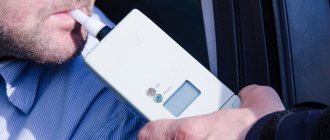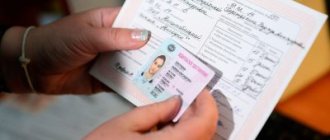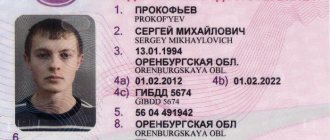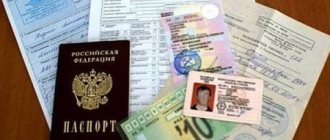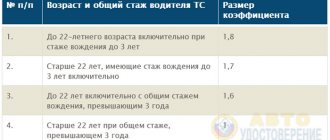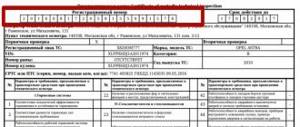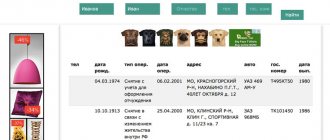If a traffic police inspector asks to be tested for alcohol, the driver can choose the place and method of analysis: on the spot, using a portable breathalyzer, as well as in a first-aid post, using stationary equipment. You can insist on checking by analyzing the composition of blood and urine. The only thing you cannot do is categorically refuse verification in any form.
There was an accident, there were injuries
Traffic police officers arriving at the scene will offer all drivers of cars involved in the accident to undergo an alcohol test right on the spot, even if they do not show signs of intoxication. This is simply the procedure when filing an accident. Drivers have a choice: agree to the procedure or refuse it:
- I agree - take several exhalations into a portable breathalyzer in the presence of others or on a video camera;
- I don’t agree - the traffic police officer records the refusal (you need to sign), and then sends you to the hospital for tests.
The analysis will show whether you have alcohol, psychotropic and other prohibited substances in your blood.
Paper tests
The Ministry of Internal Affairs plans to change the rules for examining drivers. The department has developed a draft government resolution that introduces a new sign of intoxication. Officially, it is called this: readings from devices (equipment) indicating the detection of the presence of alcohol or narcotic drugs and psychotropic substances.
As the press service of the Ministry of Internal Affairs explained to Izvestia, we are talking about rapid testing. For example, a non-contact alcohol detector can be used, which analyzes the air exhaled by a person, or a portable paper drug test, new to the traffic police, designed for rapid analysis of saliva for drugs.
traffic police
Photo: TASS/Sergey Bobylev
Without “wheels”: the Ministry of Internal Affairs will have access to medical data of drivers
The Ministry of Health will share information about drug addicts and the mentally ill with the police
The Ministry of Internal Affairs emphasized that with their help they will carry out not the examination itself, but a preliminary check of drivers, “not limited only to organoleptic methods.” Today, traffic police officers focus on five signs. This is the smell of alcohol on the breath, unsteady posture, speech impairment, a sudden change in the color of the skin of the face, or behavior that does not correspond to the situation.
Express tests will help “if it is not obvious that motorists have “characteristic signs of alcohol or drug intoxication,” the department noted.
“The driver’s refusal to carry out such a check will not entail any legal consequences,” the press service of the Ministry of Internal Affairs states.
Today, testing with a breathalyzer is carried out only in the presence of witnesses, with mandatory video recording and filling out a protocol, noted Alexander Tonkonog, Chairman of the MCA “Alexander Tonkonog and Partners”. Based on its results, the driver may be sent for a medical examination; refusal to do so could result in deprivation of rights for 1.5–2 years and a fine of 30 thousand rubles, added Alexey Gavrishev, partner of the BMS Law Firm.
traffic police
Photo: Moscow city news agency/Andrey Nikerichev
Since the new check will be considered preliminary, no protocol or witnesses will be required, and virtually every driver can fall under it, say lawyers interviewed by Izvestia.
This is indirectly confirmed by the explanatory note to the Ministry of Internal Affairs project. It says that the new system “will allow checking a larger number of drivers ⟨…⟩ not only when carrying out targeted preventive measures, but also during the performance of everyday tasks” to monitor the execution of traffic rules.
We don’t care, we know: traffic police officers have found a way to catch drug-addicted drivers
Interim rapid tests will be carried out without witnesses
If the rapid test result is positive, the driver will be sent for a medical examination to clarify the type of drug or amount of alcohol consumed, the Ministry of Internal Affairs added.
You were stopped by a traffic police officer
The police officer will only test the driver for alcohol if they notice signs of intoxication. These include:
- slurred speech and gait;
- inappropriate behavior;
- change in complexion;
- the smell of alcohol.
Having detected at least one of the listed signs, the traffic police officer will draw up a protocol on the driver’s removal from driving the vehicle. The car will be sent to a impound lot, and its owner will be sent for a medical examination. It can also be carried out on the spot if the driver agrees.
Scheme 5: “Pop-up” numbers
This scheme is somewhat similar to the previous one. Only here your knowledge that the protocol must be completely filled out by the inspector before being sent for signature does not work. Namely: in the column “Device readings” a seemingly harmless “0” is written. And nothing is entered into the “Inspection Result”, as if by mistake. And what? — There are a lot of lines in the document, the inspector accidentally missed them.
The consequences for the driver are more than dire.
After you have left the patrol, the number “0” in the alcohol intoxication examination report suddenly turns into “0.18 mg of alcohol per liter of exhaled air”, the column “Inspection result” indicates that the driver “Agrees” with this . It's just a small matter: write in the protocol about an administrative offense under Part 1 of Art. 12.8 “Driving a vehicle while intoxicated”, which the driver refused to sign. Moreover, the presence of witnesses is no longer required to draw up a protocol. Congratulations: now, most likely, you will be deprived of your driver's license for up to two years and pay a fine of 30 thousand rubles.
Countermeasures:
To prevent this from happening to you, always ask for a copy of the alcohol intoxication test report. If the inspector later makes any changes to the protocol, such “evidence” will be easy to refute in court - after all, you have in your hands a copy of the document confirming that you were sober at the time of the inspection.
Features of on-site testing
A breathalyzer is a device with a display and control panel. The Ministry of Internal Affairs allows the use of certain brands and models of devices: “Alcotest 6510”, “Alcotector PRO-100”, “Jupiter”, “Lion Alcolmeter 500”. Each of them has an electrochemical sensor that determines the number of milligrams of alcohol in a liter of air that the test subject exhales. Before checking, the driver has the right to make sure that the device has a mark that guarantees its integrity, functionality and correct settings. The inspector must also present a certificate of verification of the device (original, stamped and signed).
The device displays test results immediately. It can show the presence of alcohol even if you haven't consumed it. The breathalyzer reacts to recently eaten candy, kefir, breath freshener, kvass, and some medications. The permissible alcohol content is no more than 0.16 mg per liter of air.
Before conducting the test, the traffic police officer must show the test subject that the device is turned off. It turns on in the presence of the driver. After a minute, a mouthpiece is inserted into the breathalyzer - a new one, removed from the vacuum packaging in the presence of the driver. The first air intake is carried out empty, so that the driver and inspector are convinced of the operability of the device. Then a breath test is done. After 20 minutes - another one. All results are printed in triplicate, one of which is given to the driver.
Based on the results of the inspection, the inspector draws up a protocol indicating whether the driver agrees with the results of the inspection. If he does not agree, he is sent for a medical examination.
New traffic police test for alcohol. How will it work
The traffic police soon plans to introduce a new method of testing drivers for the presence of alcohol and drugs in their blood. Deputy Head of the State Traffic Inspectorate Alexander Bykov spoke about this on the air of the Komsomolskaya Pravda radio station. According to him, when checking drivers, traffic police inspectors will be able to determine within a few seconds whether there is generally reason to believe that there is alcohol in the exhaled air of a motorist or not.
“If there is, we will ask the driver to undergo a full medical examination procedure,” Bykov explained. According to him, this method will allow inspectors to conduct more tests in a short time. That is, drivers who agree to take an accelerated test will not have to blow into a tube or go for a medical examination, which can take several hours. Thus, instead of two or three drivers per duty, only one inspector will be able to check 20-30 drivers in a shorter time.
Why is a simplified procedure needed?
Now, before asking a driver to blow into a breathalyzer or go for a medical examination, inspectors conduct an external analysis: they evaluate the appearance of the motorist and his behavior. Among the signs of intoxication that inspectors usually look for when dealing with suspicious drivers are the smell of alcohol on the breath, unsteady posture, speech impairment, redness on the face and “behavior inappropriate for the situation.” And when inspectors ask questions about alcohol or drug use, they carefully look at the reaction: how the driver behaves, whether he is nervous or calm.
Articles April 29, 2021 Express tests of drivers for alcohol. How it works
Video February 27, 2021 Drunk Russia. A film about those who drink and drive
It was the loss of time during the medical examination and further paperwork, including writing a report for each inspection, that traffic police inspectors complained about in conversations with an Autonews.ru correspondent.
There is also the opposite situation: a motorist stopped for inspection may be under the influence of drugs. But at the same time, behave calmly and adequately, which can mislead the policeman.
The new testing mechanics should help inspectors dispel all doubts in a few minutes and make the right decision - conduct an additional check or release the driver. To do this, they will use a non-contact detector or a paper drug test. It will be possible to send even those drivers who do not show signs of intoxication for testing.
“That is, inspectors will no longer have to draw conclusions about the condition of drivers “by the shine of their eyes,” Bykov said during an interview with Autonews.ru back in February 2021.
Step-by-step procedure for testing a driver for intoxication
There are often cases when traffic police inspectors, called upon to maintain order on the roads, begin to use their powers for illegal enrichment. They stop the driver, begin to threaten him with a breathalyzer test, which “will definitely show intoxication,” and offer to resolve the issue on the spot. The main thing is not to fall into a stupor from fear and not to follow the extortionist’s lead, you just need to defend your rights. Therefore, the first thing every car enthusiast should do is to study the specifics of the alcohol testing procedure.
Preparatory stage
If a traffic police inspector suspects a driver of driving a vehicle while intoxicated, he must first invite two witnesses or start video recording his actions. It is important to remember that disinterested persons must act as witnesses - these cannot be traffic police officers. Next, the inspector informs the potential violator about drawing up a protocol on removing the driver from driving a car and introduces him to a description of the procedure.
On-site inspection
After the preparatory stage is completed, the test itself is carried out. On the road, the driver is checked using a special device - a breathalyzer. The traffic police inspector is obliged to show the device to the potential violator, note the safety of its seal, and print out the disposable mouthpiece. The driver must be informed which test result will be considered positive, i.e. confirming his guilt. When working with a breathalyzer, a possible error must be taken into account, which can be standard or individual (the latter is confirmed by documents).
First, the inspector performs a test air intake, according to the results of which the device’s screen should show zero alcohol content. Next, the driver blows into the tube until the device makes a characteristic sound, then the result is checked. The indicator is entered into the protocol (necessarily in words), the document is signed by the inspector, the person being checked, and witnesses.
Positive result
For a driver to be declared drunk, the device must show 0.16 ppm or more per liter of exhaled air. You should not believe it when the inspector claims that negative results can only be zero - the use of some foods and drinks leads to distortion of the data. Up to the specified indicator, the driver is considered sober, unless this is refuted by the results of a medical examination.
When the device gives a positive result, the following actions are performed:
- a repeat test is carried out after 20 minutes - it is considered more accurate (a new mouthpiece is used);
- the driver agrees with the results or protests them;
- in the first case, documents about traffic violations are filled out, the violator receives one copy and is sent home by taxi or to a sobering-up center if intoxicated. The traffic police officer sends the materials to the court, which will determine the punishment;
- in the second case, a medical examination is carried out - a traffic police officer takes the driver to the clinic.
If the offender does not recognize the results shown when using a breathalyzer, but refuses to undergo a medical examination, the inspector fills out a protocol with the appropriate note and also sends the materials to the court. Such actions of the driver are automatically equated to driving a vehicle while intoxicated.
